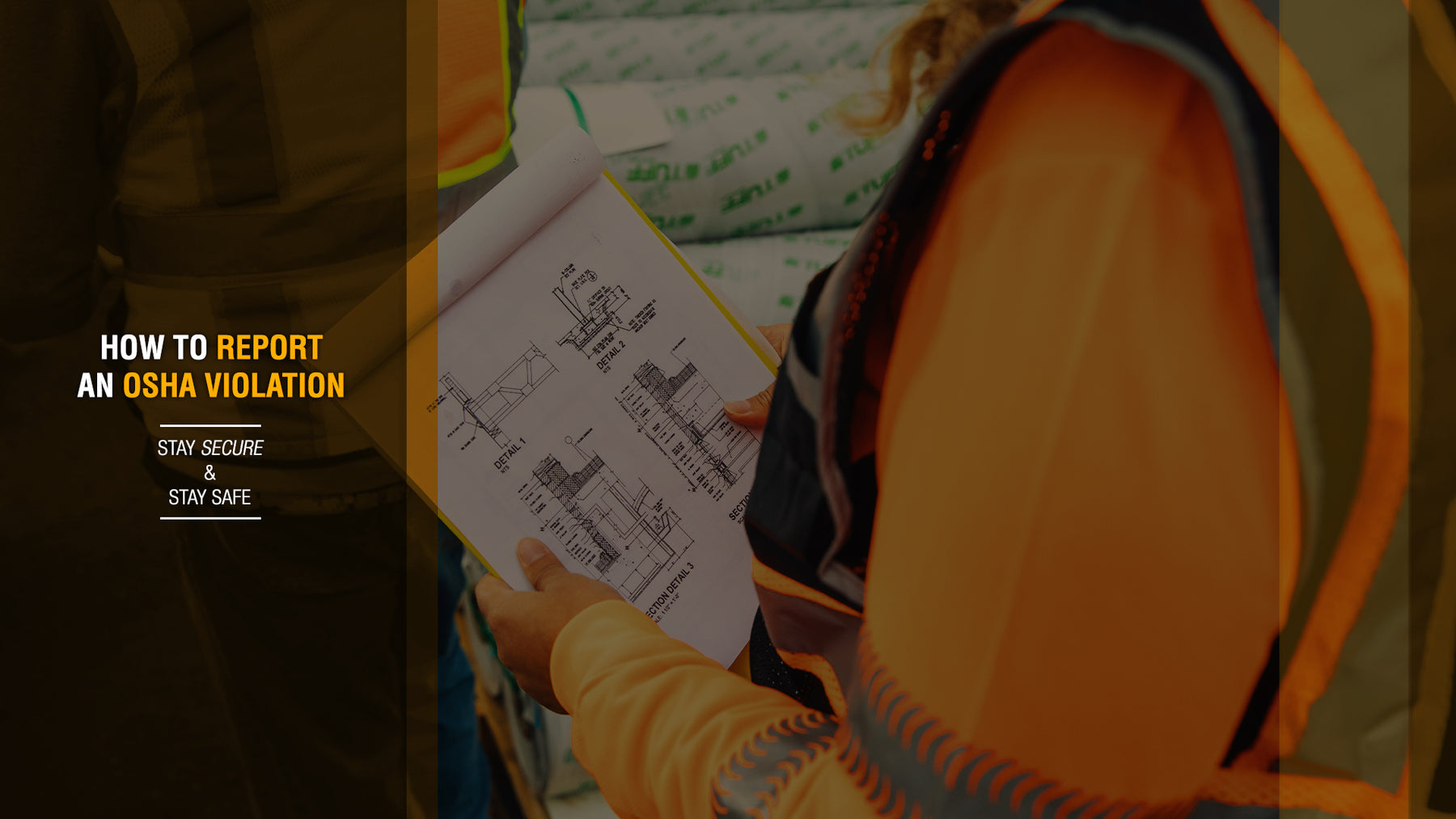Free Shipping ($25 min) | 30 Day Returns
Free Shipping ($25 min)
30 Day Returns

Workplace safety is paramount to the well-being of employees and the overall success of any organization. To safeguard workers' rights and prevent accidents, the Occupational Safety and Health Administration (OSHA) was established in the United States. OSHA is responsible for enforcing safety and health regulations in workplaces across the country. However, OSHA relies on individuals like you to report violations.
In this blog post, we'll guide you through the process of reporting OSHA violations to help maintain a safer work environment for everyone.
Before you start reporting OSHA violations, it's important to understand what constitutes a violation. OSHA violations typically fall into one of four categories:
These violations involve situations where there is a substantial probability of death or serious physical harm, and the employer should have known about the hazards.
These violations may not directly result in serious physical harm, but they still pose a risk to employees' health and safety.
Willful violations occur when an employer intentionally and knowingly violates OSHA regulations.
Employers can face repeat violations when they've previously been cited for the same or a substantially similar violation and have not rectified the issue.
To help maintain safe working conditions, OSHA establishes and enforces regulations that employers must adhere to. However, despite these regulations, certain violations continue to be more prevalent than others.
Here are the top 10 most common OSHA violations:

Fall Protection (29 CFR 1926.501): Fall protection violations consistently top the list. This category encompasses inadequate fall protection measures, such as missing guardrails, unsecured scaffolding, and unprotected roof edges. Falls remain a leading cause of workplace injuries and fatalities.
Hazard Communication (29 CFR 1910.1200): The Hazard Communication Standard requires employers to properly label and provide information about hazardous chemicals in the workplace. Violations often involve missing or inadequate hazard communication programs, labels, and Safety Data Sheets (SDSs).
Ladders (29 CFR 1926.1053): Ladder violations often relate to the improper use, maintenance, and design of ladders. Unsafe ladder practices can result in falls and injuries.
Respiratory Protection (29 CFR 1910.134): This violation typically involves failing to provide appropriate respiratory protection, inadequate fit testing, or improper storage and maintenance of respirators. Ensuring proper respiratory protection is crucial for workers exposed to harmful airborne contaminants.
Scaffolding (29 CFR 1926.451): Scaffolding violations involve issues like lack of proper assembly, inspection, or employee training. Inadequate scaffolding can lead to falls and serious injuries for workers in construction and maintenance industries.
Lockout/Tagout (29 CFR 1910.147): Lockout/Tagout violations involve failing to control hazardous energy sources during maintenance and servicing of machinery. Inadequate lockout/tagout procedures can lead to serious injuries or fatalities.
Powered Industrial Trucks (29 CFR 1910.178): Violations in this category include inadequate training, unsafe operation of forklifts, and lack of maintenance. Accidents involving powered industrial trucks can cause severe injuries and property damage.
Fall Protection - Training Requirements (29 CFR 1926.503): This subset of fall protection violations involves failing to provide proper training to employees exposed to fall hazards. Training is essential for workers to understand the risks and safety measures.
Eye and Face Protection (29 CFR 1926.102): Eye and face protection violations typically involve not providing or requiring the use of appropriate safety goggles or face shields in situations where there is a risk of eye or face injury.
Machine Guarding (29 CFR 1910.212): Machine guarding violations pertain to missing or inadequate safeguards on machines to protect workers from moving parts or hazardous operations. Failure to address this issue can result in severe injuries.
**It's important to note that OSHA continually updates its regulations and enforcement priorities. Employers should stay informed about these changes to ensure compliance and maintain a safe workplace for their employees.**
Reporting OSHA violations is a straightforward process that can help protect employees and ensure that employers are held accountable for maintaining a safe work environment. Here are the steps to follow:
If you witness or suspect an OSHA violation at your workplace, it's crucial to gather as much evidence as possible. Take photographs, videos, or detailed notes about the violation, including the date, time, location, and any individuals involved.
In some cases, it may be appropriate to first inform your immediate supervisor about the violation, especially if it's a minor issue that can be quickly addressed. Many employers are proactive in addressing safety concerns.
If the violation is not resolved or if it poses a serious threat to health and safety, you should contact OSHA directly to report the violation. You can do this through one of the following methods:
When reporting a violation, be sure to provide as much information as possible. This includes details about the violation, the workplace, any injured parties, and your contact information. You can choose to remain anonymous, but providing your information can be helpful for OSHA's investigation.
After reporting the violation, it's important to follow up with OSHA to check on the status of your report and any actions taken. OSHA may conduct inspections or investigations, and your input can be valuable in the process.
_______________________
Reporting OSHA violations is an essential step in ensuring workplace safety. By being proactive and vigilant, you can help protect yourself and your colleagues from potential harm and hold employers accountable for maintaining a safe work environment. Remember that reporting violations to OSHA not only benefits your immediate workplace but also contributes to a safer work environment nationwide. Your actions can make a difference in preventing accidents and injuries in the workplace, ultimately saving lives.
Follow us on social media to stay up-to-date on new products and much more!
{"one"=>"Select 2 or 3 items to compare", "other"=>"{{ count }} of 3 items selected"}
Leave a comment